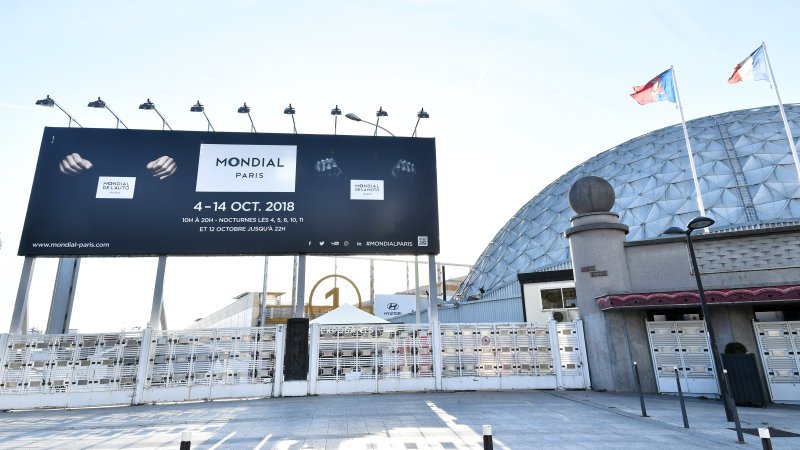The Paris Motor Show, held every other year in the early fall, typically kicks off the annual cavalcade of automotive conclaves, one that traverses the globe between autumn and spring, introducing projective, conceptual and production-ready vehicle models to the international automotive press, automotive aficionados and a public hungry for news of our increasingly futuristic mobility enterprise. But this year, at the press preview days for the show, the grounds of the Porte de Versailles convention center felt a bit more sparsely populated than usual.
This was not simply a subjective sensation, or one influenced by the center's atypically dispersed assemblage of seven discrete buildings, which tends to spread out the cars and the crowds. There were not only fewer new vehicles being premiered in Paris this year, there were fewer manufacturers there to display them. Major mainstream European OEM stalwarts such as Alfa Romeo, Fiat, Nissan and Volkswagen chose to sit out Paris this year, as did boutique manufacturers like Bentley, Aston Martin and Lamborghini.
This is not simply based in some antipathy on the part of the German, British and Italian manufacturers toward the French market — though for a variety of historical and societal reasons that market may be more dominated by vehicles produced domestically than others. Rather, it is part of a larger trend in the industry. Last year, Mercedes-Benz announced that it would not be participating in the flagship North American International Auto Show in 2019 — and that it might not return. Other brands including Jaguar/Land Rover, Audi, Porsche, Mazda and nearly every exotic carmaker have also departed the Detroit show.
Some of these brands will still appear in the city in which the show is taking place, and host an event offsite, to capitalize on the presence of a large number of reporters in attendance. And even brands that do have a presence at the show have shifted their vehicle introductions to the days before the official press opening in an attempt to stand out from the crowd.
In many ways, this makes sense. With an expanding number of automakers, with diversification and niche-ification of models and with wholesale shifts that necessitate the introduction of EV or autonomous sub-brands, there is a growing sense that, with everyone shouting at the same time, no one can be heard.
"Automakers realize the cost/benefit ratio of attending an auto show isn't justified," says Karl Brauer, executive publisher of industry analyst firm Kelley Blue Book. "In a world with increasingly sophisticated and targeted messaging options, more companies are choosing other routes."
Small- and large-scale upscale manufacturers are finding that it makes far more sense for their limited volumes and limited marketing budgets to go directly to events that their more exclusive consumers are likely to attend, motoring events such as the Pebble Beach classic car concours, the Goodwood Revival vintage car races or even more specifically lifestyle events such as polo matches, sailboat races or fine art fairs like Art Basel or Frieze.
Despite the fact that attendance remains as high or higher than ever among consumers, mainstream automakers are following a different path, and for different reasons. Attending a large motor show easily costs in the seven-figure range. "That same money can produce an extravagant and memorable gala event that lasts an evening," says Brauer. More important, instead of competing for attention with dozens of other vehicles and brands, in a disambiguated setting, he notes that these individual events are "under the automaker's complete control."
And as the car business and the technology business become increasingly intertwined, and as we prognosticate toward a future in which they become virtually indistinguishable, brands are using electronics showcases such as CES, or "ideas" conferences like South By Southwest, as a locus to introduce their new electric, autonomous, networked vehicles.
"Carmakers are leveraging a combination of high-profile events, attractive venues and social media to convey their product messaging," says Brauer. "An increasing number of brands will use these tactics instead of an auto show for critical global debuts. Beyond controlling the message, this process avoids the competitive news atmosphere of an auto show."
This can have a diminishing effect on traditional motor shows, a kind of death spiral, where, as manufacturers pull out due to the absence of their perceived competitors and compatriots, the population on the show floor declines further and further. Yet, since part of the reason for skipping out on some shows because of the broad array of voices fighting to be heard, with a press corps and public still largely present, the dwindling number of remaining brands may gain an unforeseen advantage.
"Certainly that might be an opportunity in the future," says Natanael Sijanta, marketing director for Mercedes-Benz. "But we are not about keeping alive traditional platforms for their own sake. We are about finding the best way to expand our messages to reach all target groups."
Related News



